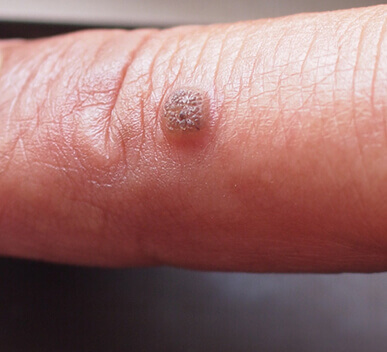A wart is a rough growth that can develop anywhere on your body. Warts may be black, dark brown or white in color. Common warts most frequently occur on the hands. Growths known as plantar warts are specific to the feet. Warts can affect anyone but are usually seen in children, people who bite their nails, and people with weakened immune systems. Although they are contagious, warts are a benign skin condition.
Tues: 8:30am - 3:00pm
Wed: 12:00pm - 6:00pm
Thurs: 8:30am - 3:00pm
Fri: Closed
Sat: 8:30am - 12:30pm
Sun: Closed
Greenvale, NY 11548
Warts


What are warts?
What causes warts?
Warts are caused by any of more than 100 different strains of human papillomavirus (HPV). The wart develops when this viral infection invades the top layer of your skin. Children are prone to developing warts as they tend to have many cuts and scrapes. Sites of shaving are other areas where warts can develop and spread. Because these viruses are contagious, they can spread from direct contact with a wart or almost anything that touches the wart. Therefore, it is recommended to avoid picking, rubbing or biting active lesions. It is also advised to wear protective shoes around pools, locker rooms and public showers.
How dermatologists diagnose warts
A detailed visual inspection of the affected area of skin will often enable your dermatologist to determine whether you have a wart. A skin biopsy to remove the wart and send it to a lab for testing may be necessary, although this is rare.
How dermatologists treat warts
Your dermatologist may propose a variety of treatments varying in intensity to get rid of your warts based on many factors including your age as well as size, location and number of warts present.
When considering treatment, it is important to remember that warts are benign and may go away on their own once the immune system recognizes the virus. The immune response will treat the virus and therefore the wart will ultimately resolve.
Home treatment can be considered as a primary treatment of the wart or may be used in conjunction with in-office procedures. Over-the-counter products containing salicylic acid are the most common home treatments for warts. However, this method can take months of daily use to see results.
A first line in-office treatment often involves cryotherapy, at which time the wart is frozen with liquid nitrogen. This may cause a blister to form in the area treated which may peel away some or all of the wart. Several sessions of cryotherapy are often needed to successfully treat warts.
Another in-office treatment involves coating the wart with cantharidin, which causes a blister below the wart, killing the virus. This method of treatment is less painful than cryotherapy but also often requires several treatments.
Other procedures involve burning off the wart with electrosurgery and scraping off the wart, known as curettage. Your dermatologist may recommend either of these treatments or both in one session to remove warts.
More intensive options for warts that do not respond to other treatments can include injections, chemical peels, surgery, or laser treatment. Immunotherapies can be used to boost your immune system to fight the virus causing warts. These treatments may be topical (applied directly to the wart) or administered with an injection. These treatments tend to be more painful and can lead to scarring.
There is no cure for warts and they may recur at previously treated sites or new sites despite treatment.
If you are concerned about warts, click here to schedule an appointment with our board-certified dermatologists or walk into Walk-in Dermatology at your convenience for immediate evaluation.






